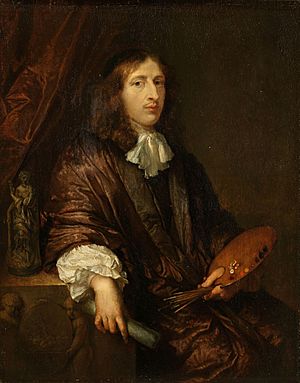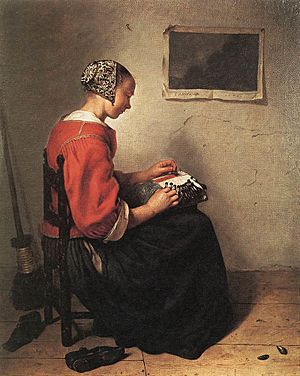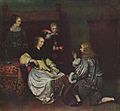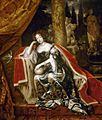Caspar Netscher facts for kids
Quick facts for kids
Caspar Netscher
|
|
|---|---|

Self-portrait of Caspar Netscher
|
|
| Born | 1639 Heidelberg or Prague
|
| Died | January 15, 1684 (Age 45) The Hague, Netherlands
|
| Nationality | Dutch |
| Style | Genre work |
Caspar Netscher (born in 1639, died in 1684) was a talented Dutch painter. He was known for his portraits and for paintings that showed everyday life, called genre paintings. Caspar was very good at painting details like fancy rugs, silk, and brocade fabrics. He brought a new, international style of painting to the Netherlands.
Contents
Life of Caspar Netscher
Early Life and Training
Caspar Netscher was born in 1639, possibly in Heidelberg or Prague. His father, Johann Netscher, was a sculptor from Stuttgart. Caspar's father died when Caspar was only two years old.
When Heidelberg was attacked during a civil war, Caspar's mother had to flee. She took her four children to a safe place outside the city. Sadly, during a siege, two of Caspar's older brothers died from hunger. His mother then escaped in the night, carrying young Caspar. She traveled with her young daughter to Arnhem, where they finally found safety.
In Arnhem, Caspar was adopted by a wealthy doctor named A. Tullekens. At first, he was expected to follow in his patron's footsteps. However, Caspar showed a great talent for painting. So, he began to study with a local artist named Hendrick Coster.
In 1654, Caspar became a student of the famous painter Gerard ter Borch in Deventer. He was considered Ter Borch's most skilled student. Caspar likely worked as an assistant and even appeared as a model in some of Ter Borch's paintings.
Moving to The Hague
When Caspar became an adult, he worked for art dealers to earn money. He saved enough to travel to Italy to continue his art education. In 1658, he sailed to Bordeaux, France. He planned to travel overland from there to Italy.
However, in Bordeaux, he met Margaretha Godijn, the daughter of a mathematician. He married her on November 25, 1659. This changed his plans, and he did not continue to Rome. In Bordeaux, he worked hard painting small, detailed pictures. These paintings are now highly valued for their beautiful finish.
After his son was born, Caspar moved back north to The Hague in 1662. He started focusing on painting portraits. He became very successful in this type of art. In 1668, he joined a local militia group called the Schutterij. Around this time, Cosimo III de' Medici, a powerful Italian prince, visited the Netherlands and bought four of Caspar's paintings.
Later Career and Legacy
Caspar Netscher likely knew other famous painters like Frans van Mieris, Sr. and Gerard Dou. He was certainly friends with Gerrit de Hooch from The Hague. In fact, Caspar and his wife were present when Gerrit's daughter Margarita was born in 1676.
Caspar was supported by important people, including William III, who later became King of England. His success allowed him to paint more of what he loved: scenes of music and conversations. These paintings truly showed off Netscher's talent. He often painted women dressed in shiny satin fabrics, a style he learned from Ter Borch. His paintings were known for their delicate brushwork, bright colors, and pleasing use of light and shadow.
Caspar Netscher gained both fame and wealth. However, he began to suffer from gout, a painful illness. He continued to paint even while lying in bed. He died at a young age in 1684 in The Hague.
His sons, Constantyn (1668–1722) and Theodorus (1661–1732), also became painters. They followed their father's style. Caspar also had many students, including Johannes van den Brande and Aleida Wolfsen.
Gallery
See also
 In Spanish: Caspar Netscher para niños
In Spanish: Caspar Netscher para niños










